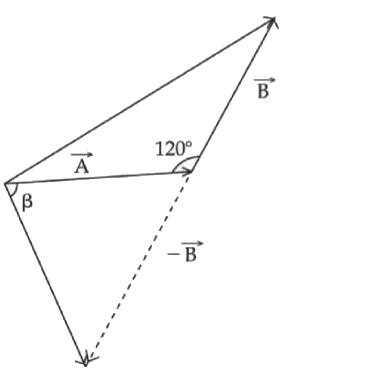What will be the angle between the vectors →Aand→B if →A+→B=→R and A2+B2=R2?
To find the angle between the vectors →A and →B given the conditions →A+→B=→R and A2+B2=R2, we can follow these steps:
1. Understanding the Given Equations:
We are given two equations:
- →A+→B=→R
- A2+B2=R2
2. Taking Magnitudes:
From the first equation, we can take the magnitude of both sides:
|→A+→B|=|→R|
This implies:
|→A+→B|2=|→R|2
3. Expanding the Magnitude:
The magnitude of the sum of two vectors can be expressed as:
|→A+→B|2=A2+B2+2ABcosθ
where θ is the angle between vectors →A and →B.
4. Substituting the Magnitudes:
From the second equation, we know that:
A2+B2=R2
Therefore, we can substitute R2 into our equation:
A2+B2+2ABcosθ=R2
This simplifies to:
R2+2ABcosθ=R2
5. Cancelling R2:
By cancelling R2 from both sides, we get:
2ABcosθ=0
6. Analyzing the Result:
The equation 2ABcosθ=0 implies that either A=0, B=0, or cosθ=0. Since we are looking for the angle, we focus on cosθ=0.
7. Finding the Angle:
The value of cosθ=0 occurs when:
θ=π2 radians(or 90 degrees)
Conclusion:
The angle between the vectors →A and →B is π2 radians (or 90 degrees).
---
We are given two equations:
- →A+→B=→R
- A2+B2=R2
From the first equation, we can take the magnitude of both sides:
|→A+→B|=|→R|
This implies:
|→A+→B|2=|→R|2
The magnitude of the sum of two vectors can be expressed as:
|→A+→B|2=A2+B2+2ABcosθ
where θ is the angle between vectors →A and →B.
From the second equation, we know that:
A2+B2=R2
Therefore, we can substitute R2 into our equation:
A2+B2+2ABcosθ=R2
This simplifies to:
R2+2ABcosθ=R2
By cancelling R2 from both sides, we get:
2ABcosθ=0
The equation 2ABcosθ=0 implies that either A=0, B=0, or cosθ=0. Since we are looking for the angle, we focus on cosθ=0.
The value of cosθ=0 occurs when:
θ=π2 radians(or 90 degrees)
The angle between the vectors →A and →B is π2 radians (or 90 degrees).
Topper's Solved these Questions
- BOOK - MODERN PUBLICATIONCHAPTER - MOTION IN A PLANE EXERCISE - Revision Exercises (Long Answer Question)6videos
MOTION IN A PLANE
- BOOK - MODERN PUBLICATIONCHAPTER - MOTION IN A PLANE EXERCISE - Revision Exercises (Numerical Problems)26videos
MOTION IN A PLANE
- BOOK - MODERN PUBLICATIONCHAPTER - MOTION IN A PLANE EXERCISE - Revision Exercises (Fill in the Blanks)9videos
MOTION IN A PLANE
- BOOK - MODERN PUBLICATIONCHAPTER - MECHANICAL PROPERTIES OF FLUIDSEXERCISE - Chapter Practise Test16videos
MECHANICAL PROPERTIES OF FLUIDS
- BOOK - MODERN PUBLICATIONCHAPTER - MOTION IN A STRAIGHT LINE EXERCISE - CHAPTER PRACTICE TEST16videos
MOTION IN A STRAIGHT LINE
Similar Questions
Knowledge Check
- Question 1 - Select One
The angle between vectors (→A×→B)and(→B×→A) is :
Aπ radBπ2 radCπ4 radDzero - Question 2 - Select One
What is the angle between →a and the resultant of →a+→b and →a−→b ?
A0Btan−1abCtan−1baDtan−1(a−b)(a+b) - Question 3 - Select One
If θ is the angle between unit vectors →A and →B, then (1−→A.→B)1+→A.→B⎞⎟ ⎟⎠ is equal to
Atan2(θ/2)Bsin2(θ/2)Ccot2(θ/2)Dcos2(θ/2)
What are the properties of two vectors →A and →B such that:
(a) →A+→B=CandA+B=C
(b) →A+→B=→CandA2+B2=C2View SolutionWhat is the property of two vectores →Aand→B if:
(A) ∣∣→A+→B∣∣=∣∣→A−→B∣∣ (b) →A+→B=→A−→BView SolutionThe vector →a+→b bisects the angle between the vectors ˆaandˆb if (A) |→a|+∣∣→b∣∣=0 (B) angle between →aand→b is zero (C) |→a|=∣∣→b∣∣=0 (D) none of these
View SolutionGiven that A=B. What is the angle between (→A+→B) and (→A−→B) ?
View SolutionGiven that A=B. What is the angle between (→A+→B)and(→A−→B) ?
View Solution


